
|

|
|
Funny on other blogs: Privacy Policy |
�
10 Greatest Robberies of all time Published on 8/23/2006 Central Bank of Iraq (2003): Saddam took US$1 billion a day before the war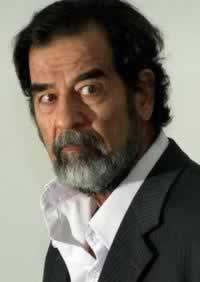 In March 2003, on several occasions beginning on March 18, the day before the United States began bombing
Baghdad, nearly US$1 billion was stolen from the Central Bank of Iraq. This is considered the largest bank
heist in history.
In March 2003, on several occasions beginning on March 18, the day before the United States began bombing
Baghdad, nearly US$1 billion was stolen from the Central Bank of Iraq. This is considered the largest bank
heist in history.
Approximately $650 million was later found hidden in walls in Saddam Hussein's palace by US troops. It is believed that this was the bulk of the stolen money. The remaining money is currently unaccounted for. Diyaa Habib al-Khayoun, general manager of the state-owned al-Rafidain Bank, claims that $250 million and 18 billion now worthless Iraqi dinars were also stolen, but by professional robbers unconnected to Saddam. In March 2003, a hand-written note surfaced, signed by Saddam, ordering $920 million to be withdrawn and given to his son Qusay. Bank officials state that Qusay and another unidentified man oversaw the cash, boxes of $100 bills, being loaded into trucks during a five hour operation. Qusay was later killed by US troops in a firefight. Boston Museum (1990): dressed as police officers, stole US$300 million worth in paintings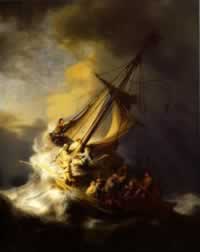 Hours after St. Patrick's Day festivities wrapped up in Boston on March 18, 1990, two men dressed as police
officers knocked on the security entrance side door of the Isabella Stewart Gardner Museum at 1:24 a.m. "The
policy has always been that you don't open that door in the middle of the night for God. Why on this one
night they opened the door no one can explain," Lyle Grindle, the museum's current head of security, told
Access Control & Security Systems, a security industry trade publication. Grindle was not in charge of
security at the time of the 1990 heist. Just minutes after letting them in, the guards quickly learned that
the late night visitors weren't real cops. Though they apparently did not brandish any weapons, the
intruders managed to overpower the two guards. They handcuffed the guards, bound them with duct tape and
left them in the basement.
Hours after St. Patrick's Day festivities wrapped up in Boston on March 18, 1990, two men dressed as police
officers knocked on the security entrance side door of the Isabella Stewart Gardner Museum at 1:24 a.m. "The
policy has always been that you don't open that door in the middle of the night for God. Why on this one
night they opened the door no one can explain," Lyle Grindle, the museum's current head of security, told
Access Control & Security Systems, a security industry trade publication. Grindle was not in charge of
security at the time of the 1990 heist. Just minutes after letting them in, the guards quickly learned that
the late night visitors weren't real cops. Though they apparently did not brandish any weapons, the
intruders managed to overpower the two guards. They handcuffed the guards, bound them with duct tape and
left them in the basement.
In the fewer than 90 minutes that followed, the bandits went through the museum's Dutch Room on the second floor and stole three Rembrandts, including the Dutch artist's only seascape, "Storm on the Sea of Galilee." It was one of several works the thieves savagely cut to release it from its frame, leaving ragged edges of the canvas behind in otherwise empty frames, which continue to hang in the museum to this day. Also taken from that room was "The Concert" by Vermeer, as well as a Chinese bronze beaker located near the Rembrandt. The thieves also apparently tried to steal a fourth Rembrandt but were unsuccessful. Nearby, they also made off with "Landscape with an Obelisk," an oil painting by Govaert Flinck that was until recently attributed to Rembrandt, Flinck's mentor. On the other side of the floor, the thieves went into the Short Gallery and ripped five Degas sketches from the wall. Feet away a bronze eagle that adorned the top of a Napoleonic flag was also pillaged. A Manet portrait, located in the museum's Blue Room on the first floor, capped off the list of works the thieves stole. It is not known in what order the rooms were ransacked, since the thieves ripped out the surveillance tape before fleeing the museum with it. To this day, the small museum isn't able to collect insurance, since it carried no insurance policy at the time of the heist. Knightsbridge Security Deposit (1987): requested to rent a safe deposit box, then subdued the manager and stole US$111 million The Knightsbridge Security Deposit robbery took place on 12 July 1987 in Knightsbridge, England, part of the
City of Westminster in London. Two men entered the Knightsbridge Safe Deposit Centre and requested to rent a
Safe deposit box. After being shown into the vault, they produced hand guns and subdued the manager and
security guards.
The Knightsbridge Security Deposit robbery took place on 12 July 1987 in Knightsbridge, England, part of the
City of Westminster in London. Two men entered the Knightsbridge Safe Deposit Centre and requested to rent a
Safe deposit box. After being shown into the vault, they produced hand guns and subdued the manager and
security guards.
The thieves then hung a sign on the street level door explaining that the Safe Deposit Centre was temporarily closed, whilst letting in further accomplices. They broke open many of the safe deposit boxes and left with a hoard estimated to be worth £40 million (equivalent to roughly US$66 million at the 1987 exchange rate; the inflation-adjusted value would be £63.6 million --$111 million-- as of 2005). One hour after the robbers departed, one of the guards managed to escape his handcuffs to raise the alarm. Police forensic investigators at the crime scene recovered a fingerprint that was traced to the Italian Valerio Viccei. After a period of surveillance, Viccei and several of his accomplices were arrested during a series of coordinated raids on 12 August 1987 and later convicted of the crime. Viccei would later published a book on the robbery. Kent Securitas Depot (2006): abducted the manager, then stole USD$92.5 million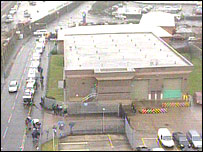 The Securitas depot robbery was a robbery which took place in the early hours of 22 February 2006, between
01:00 and 02:15 UTC in England, an operation that succeeded in stealing the largest cash amount in British
crime history. At least six men abducted and threatened the family of the manager, tied up fourteen staff
members and stole £53,116,760 (about US$92.5 million or €78 million) in bank notes from a Securitas Cash
Management Ltd depot in Vale Road, Tonbridge, Kent.
The Securitas depot robbery was a robbery which took place in the early hours of 22 February 2006, between
01:00 and 02:15 UTC in England, an operation that succeeded in stealing the largest cash amount in British
crime history. At least six men abducted and threatened the family of the manager, tied up fourteen staff
members and stole £53,116,760 (about US$92.5 million or €78 million) in bank notes from a Securitas Cash
Management Ltd depot in Vale Road, Tonbridge, Kent.
The manager of the depot, Colin Dixon, was abducted at about 18:30 on 21 February, apparently while driving his Nissan Almera to his home in Herne Bay. He was pulled over on the A249 just outside Stockbury, a village North East of Maidstone, by what he thought was an unmarked police vehicle due to the blue lights behind the front grill. A man approached him in high-visibility clothing and a police-style hat. The manager proceeded to get into the police imposter's car, thinking that he was a police officer, where he was then handcuffed by others in the vehicle. He was then driven west on the M20 motorway to the West Malling bypass where he was bound further, transferred into a white van and transported to a farm in an unknown location in west Kent. As this was taking place, the manager's wife and eight-year-old son were being held hostage at their home in Herne Bay, after they answered the door to men dressed in police uniforms, who falsely informed them that the manager had been involved in a road traffic accident. They were then driven to the farm at which the manager was being held, where he was told at gunpoint that failure to cooperate could put him and his family in danger. The depot manager, his wife and son were taken to the Securitas depot in Tonbridge at around 01:00, travelling in a plain white van, being held at gunpoint. At the depot, 14 members of staff were bound by robbers, armed with handguns and wearing balaclavas. The heist came to an end at approximately 02:15, although it was still another hour before staff members, who had been tied up, managed to raise the alarm. Police officers arriving on the scene discovered staff, the manager and his family, bound but physically unharmed. Great Train Robbery (1963): stole US$74 million without guns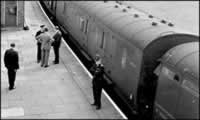 The Great Train Robbery was the name given to a £2.3 million train robbery committed on 8 August 1963 at
Bridego Railway Bridge, Ledburn near Mentmore in Buckinghamshire, England.
The Great Train Robbery was the name given to a £2.3 million train robbery committed on 8 August 1963 at
Bridego Railway Bridge, Ledburn near Mentmore in Buckinghamshire, England.
The Royal Mail's Glasgow to London travelling post office (TPO) train was stopped by tampered signals. A 15-member gang, led by Bruce Reynolds and including Ronnie Biggs, Charlie Wilson, Jimmy Hussey, John Wheater, Brian Field, Jimmy White, Tommy Wisbey, Gordon Goody and Buster Edwards, stole £2.3 million in used £1, £5 and £10 notes — the equivalent of £40 million (US $74 million) in 2006. Although no guns were used in the robbery, the train driver, Jack Mills, was hit on the head with an iron bar, causing a black eye and facial bruising. The assailant was one of three members of the gang never to be arrested or identified. Frank Williams (at the time a Detective Inspector) claims to have traced the man, but he could not be charged because of lack of evidence. Mills recovered fully from the attack and died in 1970 from leukemia. Thirteen of the gang members were caught after police discovered their fingerprints at their hideout at Leatherslade Farm, near Oakley, Buckinghamshire. The robbers were tried, sentenced and imprisoned. Ronnie Biggs escaped from prison 15 months into his sentence, settling in Melbourne Australia, and later moving to Rio de Janeiro, Brazil, when police found out his Melbourne address. Charlie Wilson escaped and was living outside Montreal, Canada on Rigaud Mountain. In the upper-middle-class neighbourhood where the large, secluded properties are surrounded by trees, Wilson was just another resident who enjoyed his privacy. Only when his wife made the mistake of telephoning his parents in England was Scotland Yard able to track him down. Banco Central in Brazil (2005): tunneled 255 feet up to the bank, then stole US$69.8 million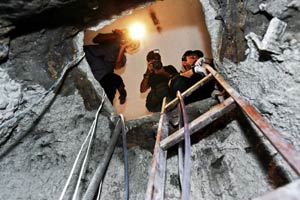 On the weekend of August 6 and August 7, 2005 a gang of burglars, suspected to be either the Gang of the
Tattooed or Primeiro Comando da Capital, tunneled into the Banco Central in Fortaleza. They removed five
containers of 50-real notes, with an estimated value of 164,755,150 reais (US$69.8 million, £38.6 million,
€56 million). The money was uninsured; a bank spokeswoman stated that the risks were too small to justify
the insurance premiums. The burglars managed to evade or disable the bank's internal alarms and sensors; the
burglary remained undiscovered until the bank opened for business on the morning of Monday, August 8.
On the weekend of August 6 and August 7, 2005 a gang of burglars, suspected to be either the Gang of the
Tattooed or Primeiro Comando da Capital, tunneled into the Banco Central in Fortaleza. They removed five
containers of 50-real notes, with an estimated value of 164,755,150 reais (US$69.8 million, £38.6 million,
€56 million). The money was uninsured; a bank spokeswoman stated that the risks were too small to justify
the insurance premiums. The burglars managed to evade or disable the bank's internal alarms and sensors; the
burglary remained undiscovered until the bank opened for business on the morning of Monday, August 8.
The Banco Central is a national banking institution charged with control of the money supply. The money in the vault was being examined to see if it should be recirculated or destroyed. The bills were not numbered sequentially, making them almost impossible to trace. Three months earlier, the gang of burglars had rented an empty property in the centre of the city and then tunneled 78 meters (255 ft) beneath two city blocks to a position beneath the bank. The gang had renovated a house and put up a sign indicating it was a landscaping company selling both natural and artificial grass as well as plants. Neighbours, who estimated that the gang consisted of between six and ten men, described how they had seen van-loads of soil being removed daily, but understood this to be a normal activity of the business. The tunnel, being roughly 70 cm (2.3 ft) square and running 4 meters (13 ft) beneath the surface, was well-constructed: it was lined with wood and plastic and had its own lighting and air conditioning systems. On the final weekend, the gang broke through 1.1 meters (3.6 ft) of steel-reinforced concrete to enter the bank vault. The bank notes weighed approximately 3,500 kg (approx. 7,700 lbs) and would have required a considerable amount of time and effort to remove. On October 22 the body of the suspected mastermind, Luis Fernando Ribeiro, 26, was found 9 October on an isolated road near Camanducaia, 200 miles (320 km) west of Rio de Janeiro. He had been shot seven times and had marks on his wrists as if he had been handcuffed. Five men were arrested September 28 with about $5.4 million of the money and told the police they had helped dig the tunnel. So far, authorities have recovered more than $7 million but $63 million remains unaccounted for. Northern Bank (2004): bank officials threatened to help steal US$50 million The Northern Bank robbery was a large robbery of cash from the headquarters of the Northern Bank in Belfast,
Northern Ireland. Carried out by a large, proficient group on 20 December 2004, the gang seized £26.5
million in pounds sterling, making it one of the biggest bank robberies in British history. The police and
the British and Irish governments claimed the Provisional IRA was responsible (or had permitted others to
undertake the raid), a claim vehemently denied by the Provisional IRA itself and the Sinn Féin political
party. The robbery, and the allegations and counter-allegations surrounding it, threw the Northern Ireland
peace process into crisis.
The Northern Bank robbery was a large robbery of cash from the headquarters of the Northern Bank in Belfast,
Northern Ireland. Carried out by a large, proficient group on 20 December 2004, the gang seized £26.5
million in pounds sterling, making it one of the biggest bank robberies in British history. The police and
the British and Irish governments claimed the Provisional IRA was responsible (or had permitted others to
undertake the raid), a claim vehemently denied by the Provisional IRA itself and the Sinn Féin political
party. The robbery, and the allegations and counter-allegations surrounding it, threw the Northern Ireland
peace process into crisis.
On the night of Sunday December 19, 2004 groups of armed men called at the homes of two officials of the Northern Bank, one in Downpatrick in County Down, the other in Poleglass, near Belfast. Masquerading as police officers, they entered the homes and held the officials and their families at gunpoint. Bank official Chris Ward was taken from Poleglass to Downpatrick, the home of his supervisor Kevin McMullan, while gunmen remained at his home with his family. Subsequently Mr McMullan's wife was taken from their home and held, also at gunpoint, at an unknown location. The following day both officials were instructed to report for work at the bank's headquarters at Belfast's Donegall Square West as normal. They did so, and remained at work after the close of business, and later in the evening they gave admittance to other members of the gang. The robbers entered the bank's cash handling and storage facility. This held an unusually large amount of cash, in preparation for distribution to ATMs for the busy Christmas shopping season. Cash was transferred to one or several vehicles (possibly including a white "Luton" van) at the premises' Wellington Street entrance, and the gang fled. Shortly before midnight the gang holding the Ward family left, and those holding Mrs McMullan released her in a forest near Ballynahinch. The haul included £10m of uncirculated Northern Bank sterling banknotes, £5.5m of used Northern Bank sterling notes, £4.5m of circulated sterling notes issued by other banks, and small amounts of other currencies, largely Euros and U.S. Dollars. Brinks Mat warehouse (1983): broke into warehouse to find ten tonnes of gold bullion worth US$45 million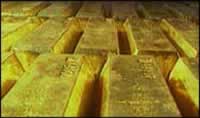 The Brinks Mat Robbery occurred on 26 November 1983 when six robbers broke into the Brinks Mat warehouse at
Heathrow Airport, England. The robbers thought they were going to steal £3 million in cash; however when
they arrived they found ten tonnes of gold bullion (worth £26 million). The gang got into the warehouse
thanks to security guard Anthony Black, who was the brother-in-law of the raid's architect Brian Robinson.
Scotland Yard quickly discovered the family connection and Black confessed to aiding and abetting the
raiders, providing them with a key to the main door and giving them details of security measures. Tried at
the Old Bailey, Robinson and gang leader Michael McAvoy were each sentenced to 25 years imprisonment for
armed robbery. Black got six years, and served three.
The Brinks Mat Robbery occurred on 26 November 1983 when six robbers broke into the Brinks Mat warehouse at
Heathrow Airport, England. The robbers thought they were going to steal £3 million in cash; however when
they arrived they found ten tonnes of gold bullion (worth £26 million). The gang got into the warehouse
thanks to security guard Anthony Black, who was the brother-in-law of the raid's architect Brian Robinson.
Scotland Yard quickly discovered the family connection and Black confessed to aiding and abetting the
raiders, providing them with a key to the main door and giving them details of security measures. Tried at
the Old Bailey, Robinson and gang leader Michael McAvoy were each sentenced to 25 years imprisonment for
armed robbery. Black got six years, and served three.
Prior to his conviction McAvoy had entrusted part of his share to an associate John Perry. Perry recruited Kenneth Noye (who had links with a legitimate gold dealer in Bristol) to dispose of the gold. Noye melted down the bullion and recast it for sale. However the sudden movements of large amounts of money through a Bristol bank came to the notice of the Treasury who informed the police. Noye was placed under police surveillance and in January 1985 killed an officer he discovered in his garden. At the resulting trial the jury found him not guilty on the grounds of self-defence. In 1986 Noye was found guilty of conspiracy to handle the Brinks Mat gold, fined £700,000 and sentenced to 14 years in prison. Three tonnes of stolen gold has never been recovered. It is claimed that anyone wearing gold jewellery bought in the UK after 1983, is probably wearing Brinks Mat. Dunbar Armored (1997): inside man steals US$18.9 millionThe Dunbar Armored robbery is the largest cash robbery to have occurred in the United States. It occurred in 1997 at the Dunbar Armored facility in Los Angeles, California. The thieves made off with some 18.9 million U.S. Dollars.The robbery was masterminded by Allen Pace, who worked for Dunbar as a regional safety inspector. While on the job, Pace had time to photograph and examine the company's Los Angeles armored car depot. He recruited five of his childhood friends, and on the night of Friday, September 13, 1997, Pace used his keys to gain admittance to the facility. Pace had timed the security cameras and determined how they could be avoided. Once inside, they waited within the staff cafeteria, ambushing the guards one by one. Pace knew that on Friday nights the vault was open due to the large quantities of money being moved. Rushing the vault guards, the robbers managed to subdue them before they could signal any alarms. In half an hour, the robbers had loaded millions of dollars into a waiting U-Haul. Pace knew exactly which bags contained the highest denomination and non-sequential bills. He also knew where the recording devices for the security cameras were located and took these. The police immediately realized it was an inside job and closely examined Pace, but could find nothing. The gang worked hard to conceal their new wealth, laundering it through property deals and phony businesses. Eventually, one of the gang members, Eugene Lamar Hill, erred when he gave an unknowing associate a stack of bills still wrapped with the original cash straps. The associate went to the police and Hill was arrested. Hill soon confessed and named his associates. Allen Pace was arrested and sentenced to twenty-four years in jail. Only a fraction of the money was ever recovered. Some $10 million is still unaccounted for. Lufthansa (1978): US$5.8 million at Kennedy Airport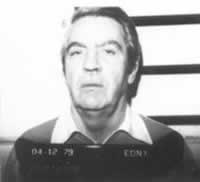 The 1978 Lufthansa Heist was planned by Jimmy Burke (immortalized in Martin Scorcese's Goodfellas), an
associate of the Lucchese crime family, and carried out by several of his associates. It all began when
bookmaker, Martin Krugman, told Henry Hill (an associate of Jimmy Burke's) about millions of dollars in
untraceable money. The money was flown in once a month and was the money exchanged by servicemen and
tourists in West Germany and that it was stored in a cardboard vault at Kennedy Airport. The information had
come from Louis Werner, who owed Krugman $20,000 in gambling debts and worked at the airport.
The 1978 Lufthansa Heist was planned by Jimmy Burke (immortalized in Martin Scorcese's Goodfellas), an
associate of the Lucchese crime family, and carried out by several of his associates. It all began when
bookmaker, Martin Krugman, told Henry Hill (an associate of Jimmy Burke's) about millions of dollars in
untraceable money. The money was flown in once a month and was the money exchanged by servicemen and
tourists in West Germany and that it was stored in a cardboard vault at Kennedy Airport. The information had
come from Louis Werner, who owed Krugman $20,000 in gambling debts and worked at the airport.
On December 11th, at 3.12 a.m. a guard, named Kelly Whalen, patrolling the cargo terminal, spotted a black Ford Econoline van pulling into a bay near a loading platform, for vaults. Whalen walked toward the loading bay, to investigate this peculiar appartion and was struck over the head with a .45 pistol. A wiry man in a black ski mask pulled his mask over his face as the blood began to pour from Whalen's wound. Another man grabbed Whalen's gun and thus disarmed him. Whalen was ordered, by the two men, to disarm the silent alarm, after he did this he was handcuffed behind his back. He saw a series of other men, all carrying rifles or pistols, running into the cargo terminal and then another man took his wallet and said that they knew where his family were and that they had men ready to visit them. Whalen nodded to indicate that he would co-operate with the thieves. Another guard, Rolf Rebmann, heard a noise by the loading ramp and when he went to investigate, 6 armed, masked men forced their way in and handcuffed him. They then used a one of a kind key from Werner and walked through a maze of corridors to where the two other employees would be. Once these two had been rounded up two gunmen ventured downstairs to look for unexpected visitors and then the other men marched the employees to a lunch room, where the other employees were on a 3 a.m. break. The gunmen burst into the lunch room and brandishing their firearms they showed a bloodied Whalen as an indication of their intentions if anyone got out of line. They knew each employee by name and forced them onto the ground. They made John Murray, the terminal's senior cargo agent, call Rudi Eirich on the intercom. The robbers knew that Eirich was the only guard that night who knew the right combinations to open the double door vault. Murray was made to pretend, to Eirich, that there was a problem with a load from Frankfurt and told Eirich to meet him in the cafeteria. As Eirich approached the cafe he was met by two shotguns and he saw the other employees, bound and gagged on the cafeteria floor. One gunman kept watch over the 10 employees and the other 3 took Eirich, at gun point, down two flights of stairs to the double door vault. He later reported that the men were informed and knew all about the safety systems in the vault and they knew about the double door system, whereby one door must be shut or the other one can't be opened or the alarm will be activated. The men ordered Eirich to open up the first door, to a 10-by-20 foot room. They knew that if he opened up the second door he would activate an alarm to the Port Authority. Once inside they ordered Eirich to lie on the ground and they then began sifting through invoices and freight manifests to determine which parcels they wanted of the many similarly wrapped ones. Finally they began hurling parcels through, one nearly hit Eirich's head, he saw it kicked open and said that inside was stacks and stacks of cash. Around 40 parcels were removed and Eirich was made to lock the inner door before unlocking the outer door because this would trigger an alarm to the Port Authority office. Two of the gunmen were assigned to load the parcels into the vans while the others tied up Eirich. A man, without a ski mask on, burst into the cafeteria and was euphoric, he said to the other gunmen that they had the money in the vans. He was quickly told to put on his ski mask by the other thieves, however some of the employees caught a glimpse of his face. They were told not to call the Port Authority until 4:30 a.m., when the men left it was 4:16 a.m. according to the cafeteria clock and no calls were made until 4:30, when a report of $5 million in cash and $875,000 in jewels being stolen was made. The employees complied because they knew if the police caught the men they or their families would be harmed or even killed. The robbery took only 64 minutes and was the largest cash robbery ever committed on American soil at the time. Submit to:  Del.icio.us Del.icio.us
 Netscape Netscape
 Furl Furl
 Facebook Facebook
� |
|






























